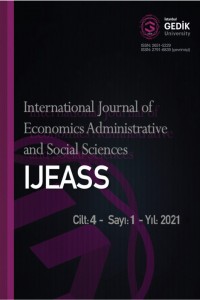Öz
Kültürel miras çalışmaları kapsamında metalaşmış mirasın kitle üzerindeki etkisini değerlendirmek için, Almanya’da bulunan Chemnitz (Eski Karl Marx Şehri) son otuz yılda geçirdiği dönüşümden ötürü vaka olarak önemli bir yere sahiptir. Bu makale Berlin Duvarı yıkılmadan kısa bir süre önce doğan ve hayatlarının çoğunu yeniden birleşme sonrası Almanya’da geçiren gençlerin kimlik oluşturma sürecini kentin anıtsal yapıları üzerinden aktarılan tarih ve sembollerle özdeşleşmeleri üzerinden okumaktadır. Genç kuşaklar için kimlik kurulumu fazla deneyimlemedikleri bir Doğu yönetimi ve eşit parçası olamadıkları bir Federal Almanya hayatı arasında gelişmektedir.
Kentin saygıdeğer bir Doğu Alman endüstriyel kentinden işsizlik problemi olan daha mütevazi bir kente dönüşmesini son yıllarda göçmenlerle çatışmaları da içeren aşırı sağ eğilimler takip etti. Makale kitlenin siyasi dönüşümünü incelememekle birlikte, Doğu Alman mekânının yeniden birleşme sonrası Almanya’da yeniden inşasının etkilerini kimlik üzerinden analiz etmektedir.
Anahtar Kelimeler
Almanya’nın birleşmesi Karl-Marx-Şehri/Chemnitz Hafıza Sergileme Dinamikleri Kimlik Kurulumu
Kaynakça
- BBC (28 August 2018) Germany migrants: Protesters face off in Chemnitz, https://www.bbc.com/news/world-europe-45324804, accessed 01.08.2020.
- City Management and Tourism Corporation City of Chemnitz, The City of Chemnitz http://www.chemnitz-tourismus.de, accessed 28.05.2011
- Crimp, D. (1999). On the Museum’s Ruins in The anti-Aesthetic: Essays on Post-Modern Culture (ed. Hal Foster). New York: The New Press, 43-56.
- Guntram, H. H. (2004). Double Vision: Territorial Strategies in the Construction of National Identities in Germany. 1949-1979, Annals of the Association of German Geographers, vol. 94, No. 1, March, 140-164.
- Hetherington, K. (1998). Expressions of Identity – Space, Performance, Politics. London: Sage Publications.
- Lefebvre, H. (2009). The Production of Space. Oxford: Blackwell Publishing.
- Lynch, K. (1960). The Image of the City, Cambridge, Massachusetts: MIT Press.
- Müller, M. (1999). Musealisation, Aestheticisation and Reconstructing the Past, The Journal of Architecture, Vol. 4, Winter, 361-367.
- Palmowski, J. (2009). Inventing a Socialist Nation-Heimat and the Politics of Everyday Life in the GDR, Cambridge: Cambridge University Press.
- Schramm, M. (2004) The Invention and Uses of Folk Art in Germany: Wooden Toys from the Erzgebirge Mountains, Folklore, vol.115, no.1, 64-76.
- Simmel, G. (1950). The Stranger, The Sociology of Georg Simmel, New York: Free Press. 402-408.
- Simmel, G. (January 01, 1903). The metropolis and mental life. Stimuli.
- Statistische Ämter des Bundes und der Länder (Statistical Offices of the Länder and the Federal Statistical Office), http://www.statistik-portal.de/Statistik-Portal/en/en_zs01_sax.asp, accessed 06.06.2011.
- Statistischer Bericht, Räumliche Bevölkerungsbewegung im Freistaat Sachsen - I. Quartal 2010, Freistaat Sachsen: Statistiches Landesamt. Technical University of Chemnitz, http://www.tu-chemnitz.de/en/, accessed 06.06.2011.
- Welt, die (2001) Eine sächsische Kommune mit Köpfchen, Die Welt, https://www.welt.de/print-welt/article491028/Eine-saechsische-Kommune-mit-Koepfchen.html, accessed 20. 09.2020.
- Welt, die (2012) Karl Marx ziert jetzt die Sparkassen-Kreditkarte, Die Welt, https://www.welt.de/wirtschaft/article108297022/Karl-Marx-ziert-jetzt-die-Sparkassen-Kreditkarte.html, accessed 20. 09.2020.
- Wild, T. and Jones, P. N. (1994) Spatial Impacts of German Unification, The Geographical Journal, vol. 160, no. 1, March1-16.
Öz
For heritage studies to evaluate the impact of the commoditized heritage on the identity development of collectivities, Chemnitz (former Karl Marx Stadt) in Germany poses an important example due to the transformations in the last three decades. This article reads the identity development of young people who were born around the fall of the Berlin Wall and lived their life in Re-unified Germany over their identification with the history and symbols narrated through the monumental structure. For young generations the identity construction is developed between belonging to an Eastern rule that they did not fully experience and not being able to find their equal place in Re-Unified Germany.
The transformation of the city from a respectable industrial city of German Democratic Republic to a humbler city with unemployment problems followed recently with the increase in far right gatherings, which also brought tensions with migrants. This article while not commenting on the political transformation of collectivities, analyzes the identity development over the impact of the re-construction of Eastern German space in Re-unified Germany.
Anahtar Kelimeler
Re-Unification of Germany Karl-Marx-Stadt/Chemnitz Memory Exhibitionary Dynamics Identity Construction
Kaynakça
- BBC (28 August 2018) Germany migrants: Protesters face off in Chemnitz, https://www.bbc.com/news/world-europe-45324804, accessed 01.08.2020.
- City Management and Tourism Corporation City of Chemnitz, The City of Chemnitz http://www.chemnitz-tourismus.de, accessed 28.05.2011
- Crimp, D. (1999). On the Museum’s Ruins in The anti-Aesthetic: Essays on Post-Modern Culture (ed. Hal Foster). New York: The New Press, 43-56.
- Guntram, H. H. (2004). Double Vision: Territorial Strategies in the Construction of National Identities in Germany. 1949-1979, Annals of the Association of German Geographers, vol. 94, No. 1, March, 140-164.
- Hetherington, K. (1998). Expressions of Identity – Space, Performance, Politics. London: Sage Publications.
- Lefebvre, H. (2009). The Production of Space. Oxford: Blackwell Publishing.
- Lynch, K. (1960). The Image of the City, Cambridge, Massachusetts: MIT Press.
- Müller, M. (1999). Musealisation, Aestheticisation and Reconstructing the Past, The Journal of Architecture, Vol. 4, Winter, 361-367.
- Palmowski, J. (2009). Inventing a Socialist Nation-Heimat and the Politics of Everyday Life in the GDR, Cambridge: Cambridge University Press.
- Schramm, M. (2004) The Invention and Uses of Folk Art in Germany: Wooden Toys from the Erzgebirge Mountains, Folklore, vol.115, no.1, 64-76.
- Simmel, G. (1950). The Stranger, The Sociology of Georg Simmel, New York: Free Press. 402-408.
- Simmel, G. (January 01, 1903). The metropolis and mental life. Stimuli.
- Statistische Ämter des Bundes und der Länder (Statistical Offices of the Länder and the Federal Statistical Office), http://www.statistik-portal.de/Statistik-Portal/en/en_zs01_sax.asp, accessed 06.06.2011.
- Statistischer Bericht, Räumliche Bevölkerungsbewegung im Freistaat Sachsen - I. Quartal 2010, Freistaat Sachsen: Statistiches Landesamt. Technical University of Chemnitz, http://www.tu-chemnitz.de/en/, accessed 06.06.2011.
- Welt, die (2001) Eine sächsische Kommune mit Köpfchen, Die Welt, https://www.welt.de/print-welt/article491028/Eine-saechsische-Kommune-mit-Koepfchen.html, accessed 20. 09.2020.
- Welt, die (2012) Karl Marx ziert jetzt die Sparkassen-Kreditkarte, Die Welt, https://www.welt.de/wirtschaft/article108297022/Karl-Marx-ziert-jetzt-die-Sparkassen-Kreditkarte.html, accessed 20. 09.2020.
- Wild, T. and Jones, P. N. (1994) Spatial Impacts of German Unification, The Geographical Journal, vol. 160, no. 1, March1-16.
Ayrıntılar
| Birincil Dil | Türkçe |
|---|---|
| Konular | Kültürel çalışmalar |
| Bölüm | Araştırma Makalesi |
| Yazarlar | |
| Yayımlanma Tarihi | 29 Haziran 2021 |
| Yayımlandığı Sayı | Yıl 2021 Cilt: 4 Sayı: 1 |

